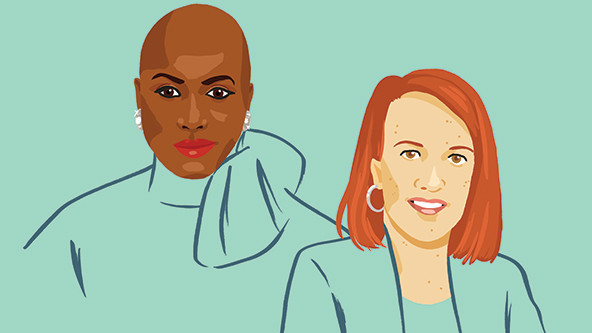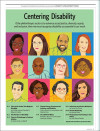 US Rep. Ayanna Pressley and Rebecca Cokley (Illustration by Shannon May)
US Rep. Ayanna Pressley and Rebecca Cokley (Illustration by Shannon May)
“Disabled people live at the intersection of all systems of oppression and social justice issues. There isn’t one issue or one intersection where you will not find disabled individuals advocating for or experiencing the effects of those issues.” — Daphne Frias, youth activist, organizer, storyteller, and peacebuilder.
Centering Disability

If the philanthropic sector is to advance social justice, diversity, equity, and inclusion, then it must recognize disability as essential to its work. This supplement offers critical perspectives and recommendations for dismantling ableism. Sponsored by the Disability & Philanthropy Forum
Last July marked the 31st anniversary of the Americans with Disabilities Act (ADA), a historic civil rights law. We have seen progress in the expansion of access to services and spaces enjoyed by Americans, but the disability community continues to experience above-average rates of poverty, incarceration, disenfranchisement, and social segregation.
And yet there is hope. We have witnessed how effective an intersectional approach to organizing is, particularly on matters of racial and environmental justice. We have seen a revitalized commitment from leaders in various sectors, including government, business, and philanthropy. The moment has come to advance and recognize the promise of disability justice in the United States.
We work in different sectors—government and philanthropy—but share the conviction that by centering disability we have an opportunity to create a just society that is more accessible and inclusive for everyone. To make this belief a reality, our efforts must center conversations that have been relegated to the sidelines as well as the voices of expert advocates who were previously siloed. Government has addressed disability for three decades, with the ADA serving as a guide. The philanthropic sector is beginning to recognize disability inclusion as a core element in its justice work and acknowledges that each grantmaking organization is at a different stage in its disability inclusion journey. Today we are sharing our personal experiences to reflect on the potential of an intersectional, cross-sector approach that will advance justice for all.
If government is to serve the people, then disability justice must be a framework we bring to every policy discussion.
Rep. Ayanna Pressley: In January 2020, I disclosed my alopecia diagnosis in an interview with The Root. The disability community welcomed me. Viewing my diagnosis as an asset and an opportunity to shed light on disability issues, members of the community reached out to me from various organizations and coalitions. In my approach to legislating, I have always prioritized intersectionality, but my dialogue with disability activists illuminated new ways in which the disability community has been systemically marginalized in public policy. Today, we are still in the civil rights movement, and the struggle for racial and disability justice are woven together. Some commentators give the impression that Rosa Parks sat, Martin Luther King Jr. spoke, John Lewis crossed a bridge, and then our full liberation was realized. But our struggle continues, and our destinies are bound together.
Far too often in the daily work of government, people are noted as numbers on a grid. But people live in intersectionality, not in checked boxes. Encouraged and emboldened by generations of activists, I am proud to be part of a new generation of leaders on Capitol Hill who take an intersectional approach to disability justice. This effort starts with recognizing that the disability community is not a monolith. From health-care access to employment, and from marriage rights to COVID-19 recovery, every policy issue is a disability issue.
In formulating my legislative agenda, I consistently look for the ways in which disability is affected by the proposals on which I am working. For example, discussions of the racial wealth gap that do not explicitly address the challenges facing Black and brown disabled people leave behind so many individuals and do not paint an accurate picture of the economic injustice these communities face. Amid the current national reckoning on racial injustice, we fundamentally believe that disability justice must be part of an intersectional conversation. We must affirm that Black disabled lives matter. Nearly half of the individuals murdered by police in the US have a disability, and Black girls with disabilities are criminalized in US schools at four times the rate of their white peers, beginning as early as preschool. We know that our systems are deeply broken, and together, we must legislate and invest in healing, justice, and accountability. We must start with honest conversations about where matters stand and what changes must follow.
The Numbers on Disability
Statistics show that disability is a natural part of the human experience. Philanthropic foundations must recognize this reality in their work.
26% (1 in 4) of American adults have some type of disability. In the United States, 61 million people live with a disability, which can be lifelong or acquired at any time. US and international law protects the rights of all people with disabilities including physical, sensory, intellectual, developmental, and mental health disabilities, as well as chronic illnesses.
15% of the global population lives with a disability. More than one billion people globally live with a disability. Eighty percent of persons with disabilities live in developing countries.
27% of people with disabilities live in poverty, compared with 12% of people without disabilities. Disabled people are more than twice as likely to live in poverty than those without disabilities. Poverty can increase the likelihood that a person with an existing health condition becomes disabled through inaccessible environments or lack of access to needed health services.
1 in 5 women in the world have a disability. Disability is part of diversity and intersects with all identities, including class, gender, race, ethnicity, and sexuality. Being disabled disproportionately affects those living in poverty, women, and people of color. People with disabilities are three times more likely to experience violence than those without disabilities.
1⁄3 of COVID-19 survivors have long-haul symptoms. People with disabilities face increased risk of contracting COVID-19, dying from COVID-19, as well as experiencing poorer health outcomes, whether or not they are infected with COVID-19. With one-third of COVID-19 survivors in the United States experi- encing long-haul symptoms, there is a “rise of long COVID as a persistent and significant health issue” that may lead to disability, according to the US Departments of Justice and Health and Human Services. If philanthropy is to build a more just and equitable society, it must combat ableism in its own institutions and practices, and recognize that disability is a key element in its work.
If the philanthropic sector is to advance social justice, diversity, equity, and inclusion, then we must recognize that disability is a key element in our work.
Rebecca Cokley: Growing up in the disability community with parents who were also little people, I saw disability as a beautiful thing. Bodies were amazing in their diversity, and people of all genders, races, and cultures found myriad ways to communicate, live, and exist. Based on the definition in the ADA, the disability community is large enough to encompass children in Flint, Michigan, who are approaching 5,000 days without clean water; Asian American victims of hate crimes; mothers with postpartum depression; and COVID-19 long-haulers. That the ADA definition of disability emphasizes the activities of daily life shows that disability is not about a diagnosis but about its effects on your life. When people assume that being a little person has the greatest impact on my quality of life, they’re wrong. It’s actually my migraines, and that’s okay.
In my role at the Ford Foundation, I am responsible for developing strategy for our US disability rights program, the first of its kind at the foundation. In 2015, when the Ford Foundation issued its declaration to move its work to challenging inequality, disability advocates spoke out about the glaring absence of a disability lens. In the past, organizations have rarely responded to this type of response, in no small part because the disability community was not considered formidable or worth listening to. But in this instance, Ford Foundation CEO Darren Walker expressed his commitment to “embracing risk and reflecting honesty,” which led the organization to examine disability bias, investigate the history of philanthropy’s negligence and harm to the community, and determine a course of action to address historic harms with solutions.
We must seize this moment to advance and recognize the promise of disability justice in America.
Rep. Pressley and Cokley: The disability community has lived segregation, from specialized educational settings to community service programs and restricted employment opportunities. Our demand to philanthropy, government, and other sectors is not to be treated as a special case. Government and foundations alike must fund efforts to develop housing proposals to ensure a supply of affordable and accessible housing. Funders exploring ways to organize efforts in criminal justice reform must remember that 60 to 80 percent of people who are currently incarcerated have a disability, including individuals who acquired a disability while incarcerated. No effective approach to reentry, abolition, or de-escalation will be successful if disability is not included.
Disability is a cause and consequence of poverty. Philanthropic organizations that are committed to fighting poverty and inequality in the United States or globally will never meet their goals as long as disability is missing from their work. Even if a foundation is discomfited by the idea of putting up a neon sign that says “We fund disability,” any philanthropic entity that addresses inequality or injustice in effective and comprehensive ways must include disability in its work. Any demographic data that is collected to understand populations served, affected, or employed must include disability if true diversity is to be reflected in the numbers.
Similarly, the federal government must move away from the bureaucratic excuses of the past, which required disabled folks to fit into specific boxes when it comes to data and benefits. This bias has resulted in public policy that does not acknowledge the community’s diversity or recognize the fundamental rights of all people to pursue liberty, justice, livable wages, marriage equality, and fair housing.
The novel coronavirus has surfaced many existing inequities, and the impact on the disability community is clear. More than a third of all deaths tied to COVID-19 come from congregate settings, where people with disabilities make up a large percentage of all residents. More than one-third of individuals impacted by the novel coronavirus are likely to experience long-haul symptoms, a brand-new category of disability. COVID-19 has exacerbated existing mental illnesses due to increases in anxiety and social isolation, and for many individuals, there have been new diagnoses. The need for flexibility and rethinking how we work, how we receive health care, and how we learn has required us all to take a moment to ask ourselves why there isn’t greater accessibility and flexibility to support how we live so that we may thrive.
Together, we can meet the moment, center individuals who are most impacted, and rebuild as a more just nation if we see disability as part of the continuing struggle for our full civil rights and liberties. We recognize that there is no justice that neglects disability.
Support SSIR’s coverage of cross-sector solutions to global challenges.
Help us further the reach of innovative ideas. Donate today.
Read more stories by Ayanna Pressley & Rebecca Cokley.

